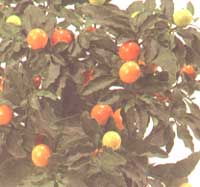Nightshade / solanum
Refers to the family of Solanaceae. Homeland - South America.
General description: Nightshade flowers in the summer with small star-shaped flowers, on the premises of which then poisonous round berries of scarlet or orange are formed. With good care, berries last for many months and a bright nightshade usually decorates the upper room for Christmas and can retain its decorativeness right up until February.
Usually a pair of nightshade species is bred:
Solanum capsicastrum - an evergreen shrub up to 1 m in height, with pubescent stems and lanceolate dark green leaves with a wavy margin.
Solanum pseudocapsicum is similar to the previous species, but the berries are larger, the leaves are shorter, only the stems are smooth. In general, the plant is brighter.
There are dwarf forms nightshade up to 30 cm high.
In the spring nightshade is pruned before transplanting, only in the autumn they produce a pinch.
Nightshade is a rather unpretentious plant.
Recommendations for the care of plants Nightshade:
Illumination : photophilous, shading is needed only in the summer noon.
Irrigation regime : Abundant during the growth period, in winter unusual.
Humidity : Needs regular spraying.
The humidity of the air is similarly supported by placing pots on a pallet with pebbles or claydite, which is continuously moistened.
For the summer it is better to place on a fresh atmosphere (in the park or on the balcony).
Temperature regime : Moderate, optimally 20 ° C, in the winter cool 12-14 ° C, not lower than 10 ° C.
Soil : Proper benign drainage is required. You can add small gravel or expanded clay.
Recommended soil mix: 2 elements of clayey sod, 2 elements of humus, 1 share of leaf land and 1 share of sand.
During the growth period, one needs fertilizing once a week with fertilizer for flowering plants ("Giant", "Rainbow" "Ideal", etc.) or a special fertilizer for tomatoes.
Breeding : Seeds and stem cuttings in spring.
Transplant : Every year in February, after the fall of berries.
Pests : It is affected by scarlet spider mites (in a dry atmosphere, leaves and stems are braided with cobwebs), aphids (form sticky excretions on shoot tips, buds), whiteflies (whitish or yellowish spots appear on the underside of leaves).
With a slight infection, the plant is allowed to help finish with a soap solution and a warm wash.
In case of severe damage, spraying with an insecticide solution (acticle, decis, phytoverm etc.) is recommended.

Nightshade pseudo-pinch - solanum pseudocapsicum
Nightshade pepsevidny - solanum capsicastrum


Comments
Commenting on, remember that the content and tone of your message can hurt the feelings of real people, show respect and tolerance to your interlocutors even if you do not share their opinion, your behavior in the conditions of freedom of expression and anonymity provided by the Internet, changes Not only virtual, but also the real world. All comments are hidden from the index, spam is controlled.